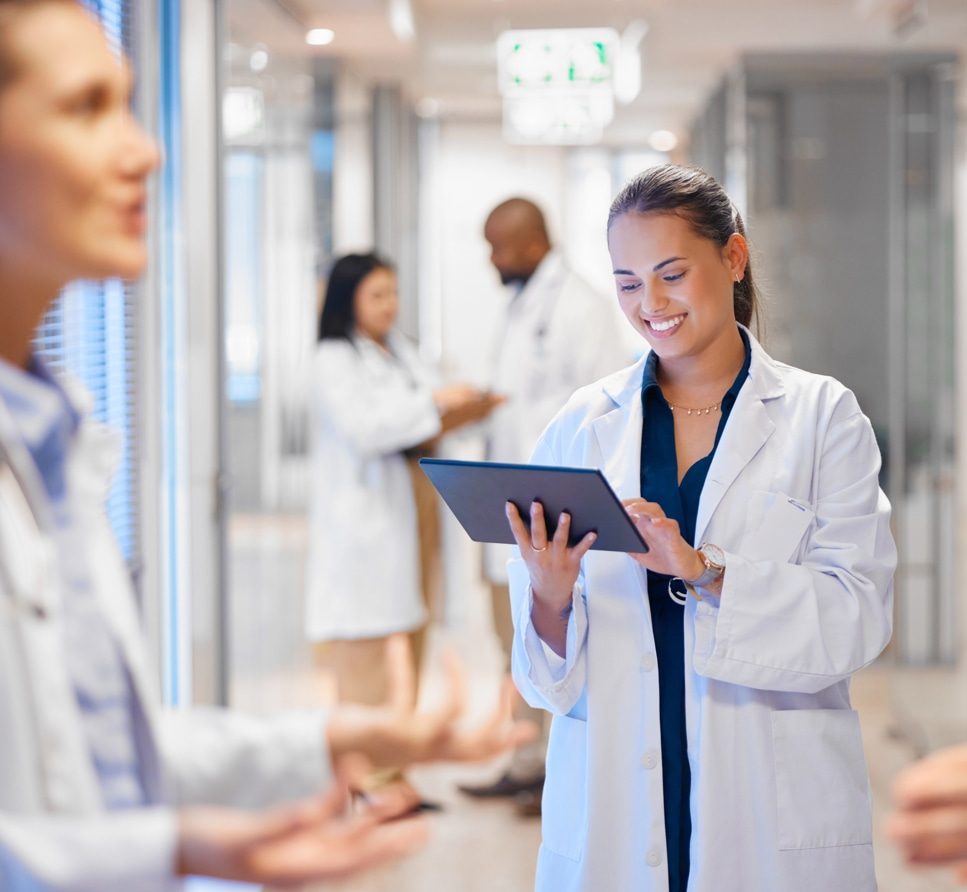Diagnosis and Treatment of Hip Labral Tears in Wake County

What is a Hip Labral Tear?
The hip is a ball-and-socket joint. The socket is called the acetabulum, which is part of the large pelvis bone, and the ball is the femoral head, located at the top of the femur (thighbone). A hip labral tear is an injury to the labrum, the soft tissue that covers the acetabulum. The labrum helps the femoral head move smoothly within the socket and also serves as a seal, keeping the ball and socket together but not touching. Learn more below about hip labral tears and how our specialists diagnose and treat this injury at Raleigh Orthopaedic.

Causes of Hip Labral Tears
Hip labral tears can be caused by many different factors. In some cases, a hip labral tear occurs following a sudden injury, while in others, damage can build over time due to repetitive movements. Causes of hip labral tears can include:
- Trauma, injury to, or dislocation of the hip joint
- Structural ailments, such as femoroacetabular impingement (FAI)
- Repetitive motions – sports-related and due to other physical activities
- Degenerative health conditions, including osteoarthritis
Symptoms of Hip Labral Tears
If you have a hip labral tear, hip pain or discomfort may get worse when you bend, move, or rotate the hip. Pain is common during exercise or sports. It is also possible to have a hip labral tear with no symptoms at all. When symptoms are present, they may include:
- A locking or clicking sound in the hip
- Pain in the groin or buttocks area
- Stiffness in the hip
- Decreased range of motion
How is a Hip Labral Tear Diagnosed?
To diagnose a hip labral tear, your Raleigh Orthopaedic physician will perform a physical examination and ask you about your symptoms, including when they began and what makes them better or worse. You will also be asked to move your leg and walk around. How well you move and any pain you feel while moving can help your doctor reach an accurate diagnosis. Imaging tests, such as X-rays and MRIs, may be ordered as they can help diagnose a hip labral tear.

Treatment Options for Hip Labral Tears at Raleigh Orthopaedic
Treatment for labral tears of the hip depends on the severity of your symptoms. Some people recover with conservative treatment in a few weeks, while others need arthroscopic surgery to repair or remove the torn part of the labrum.
A hip labral tear will not heal on its own, but rest and other conservative measures can help manage symptoms of a minor tear. Nonsurgical treatments include:
- Rest
- Anti-inflammatory medication – Non-steroidal anti-inflammatory medications such as ibuprofen and naproxen can reduce pain and inflammation
- Steroid injections – Injection of a corticosteroid along with a local anesthetic may relieve symptoms temporarily or permanently in the hip joint. If pain returns, another injection may be needed.
- Physical therapy – Specific exercises can help to stretch and strengthen the surrounding muscles
If you are experiencing deep pain in your hip area that does not improve with rest, lasts more than two weeks, and interferes with your normal activities, consult with your Raleigh Orthopaedic physician for further guidance.
Surgery to repair a labral tear in the hip is performed arthroscopically. During this minimally-invasive procedure, a series of small incisions are made around the hip joint. Your Raleigh Orthopaedic surgeon will use an arthroscope, or a thin, lighted tube-shaped instrument with a camera attached, for visual access to the joint. Then, all frayed or damaged portions of the labrum are repaired. Arthroscopic surgery is often done on an outpatient basis, so the patient can go home the same day. Scarring and recovery time are typically shorter for this procedure than open surgery.

Arthroscopy Recovery Time
Depending on the joint affected, recovery from arthroscopy can take anywhere from one week to several months. Before surgery, you and your doctor will create a recovery plan that will cover when you are able to return to work, resume daily activities, exercise, drive, etc. You will likely have a follow-up appointment after your arthroscopy, where you can make changes to your recovery plan if necessary. Exercise is essential for recovery as well, but it is important to take it slow after surgery.
Can Labral Tears in the Hip Be Prevented?
Most labrum tears occur as a result of a sports-related injury. The best way to prevent these types of injuries is through proper stretching and warm-ups before a game or practice. Stretches such as side-leg raises, donkey kicks, and squats are effective in strengthening the hip muscles. Yoga that works the lower body is also beneficial and can help prevent injury. A professional trainer can be very helpful, as they are able to show you the best way to safely train for your sport and prevent injury.

Comprehensive Labral Tear Treatment at Raleigh Orthopaedic Clinic
At Raleigh Orthopaedic, our team is committed to providing the highest quality care for patients with a variety of orthopedic conditions, including labral tears of the hip. While hip and joint pain usually isn’t life-threatening, it can significantly affect your daily life. After evaluating your symptoms, we will create a personalized treatment plan based on your needs to ensure a safe and effective recovery. To schedule an appointment at one of our convenient clinic locations across Wake County, please give us a call or book online today.









